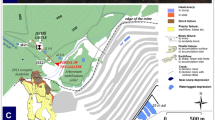Conclusions
-
1.
All outflows occurred in porphyrites, which, according to geologic-exploratory studies, were classed as water- and gas-and-water-bearing rocks at a depth of more than 600 m. In opening excavations in volcanic rocks at depths of more than 400 m, therefore, the appearance of water and gas venting must be considered an indication of potential proneness to outflow.
-
2.
The following can be classed as basic signs of porphyrite proneness to outflow: reduced strength and the extent to which the porphyrites are disturbed, increased venting of gas from blast holes during their drilling, the presence of circular macrocracks in the cores, and separation of the core into individual thin disks, or its disintegration to a state of sand. The formation of a milky-colored mud during the drilling of blast holes, and the distortion of blast holes and holes, which suggest the increased stressed state of the mass, as well as a change in the color of the porphyrite from dark-gray in segments not prone to outflow to a reddish-brown, light-gray, or green in zones prone to outflow may serve as additional criteria.
-
3.
In developing methods that ensure safe working conditions in opening tunnels in rock prone to outflow, study of the effect of slot unloading on variation in the proneness of a mass to outflow, and also the creation of technological and technical facilities to realize the antioutflow measures that have been developed should be a high priority.
Similar content being viewed by others

Literature cited
V. I. Nikolin and E. S. Matlak, “Proneness to outflow,” Bezop. Tr. v Prom., No. 12 (1977).
Instructions for Safe Mining Operations in Seams Inclined to Sudden Outflows of Coal, Rock, and Gas [in Russian], Nedra, Moscow (1977).
V. I. Nikolin, S. S. Meliksetov, and I. M. Berkovich, Rock and Gas Outflows [in Russian], Nedra, Moscow (1967).
V. I. Nikolin, Mining of Seams Prone to Outflow in Deep Shafts [in Russian], Donbass, Donetsk (1976).
N. M. Proskuryakov, V. D. Fomina, and V. K. Rozhkov, Gasdynamic Phenomena in Soligorsk Potash Mines [in Russian], Polyma, Minsk (1974).
M. I. Bol'shinskii, E. S. Matlak, et al., “Experience gained in preventing rock and gas outflows by drilling out unloading slots along the periphery of the excavation,” in: Experience with Increased Labor Safety in Working Seams Prone to Outflow [in Russian], Ékspress-Informatsiya, Moscow (1974).
Additional information
Translated from Gidrotekhnicheskoe Stroitel'stvo, No. 6, pp. 24–27, June, 1980.
Rights and permissions
About this article
Cite this article
Nikolin, V.I., Matlak, E.S., Sarkisyan, A.V. et al. Outflow of volcanic rock and gas during opening of the Arpa-Sevan tunnel. Hydrotechnical Construction 14, 581–586 (1980). https://doi.org/10.1007/BF02305402
Issue Date:
DOI: https://doi.org/10.1007/BF02305402


